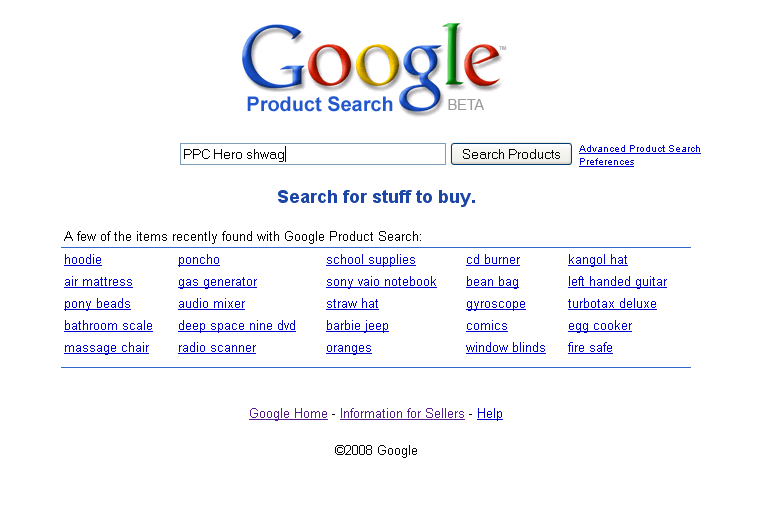Don’t Miss Out on Extra Holiday Revenue – What You Need to Know About Comparison Shopping Search Engines


Welcome to our week long exploration of the tips and tricks necessary for increasing retail sales during the holidays! As we are all aware, Black Friday and the following weeks are well, BIG. Big enough to be recognized as the most important shopping time of the year, in stores and online. Therefore, you need to plan ahead to capitalize on this opportunity to the fullest extent! Today, I am going to discuss comparison shopping search engines and how not to miss out on additional seasonal revenue.
Truth to be told, there are about three bazillion million such sites, each comparing similar products and merchants, creating confusion for advertisers trying to utilize their services. Which should one advertise with? Which ones are most used and trusted by consumers? How does it all work? Thankfully, PPC Hero will lead you through the myriad of shopping search engines! We’ll show you how to take advantage of the better-known shopping search engines, and in turn giving yourself the holiday gift of additional reach and revenue. If you just aren’t sure about these comparison shopping search engines, then this post’s for you!
First things first, some general information about comparison shopping search engines. They are called ‘comparison’ engines because they compare products and prices with thousands of merchants across the country. The benefit to consumers is the ease of shopping to find the best products with the most affordable prices in one central location. The benefit to us as advertisers is that these engines typically employ a concept you might be familiar with, Pay-Per-Click, in exchange for product listings and merchant information. You place bids for categories and listings, and in turn are only charged when a user clicks on your listing. Anyways, that’s the short and sweet of it. For more detailed information about the comparison shopping search engine industry, check out Brian Smith’s Comparison Engines Blog.
To give you a picture of the potential reach of comparison shopping search engines, check out the graph below, showing traffic for five popular shopping search engines – Bizrate, Nextag, Pricegrabber, Shopping.com, and Yahoo Shopping. After noticing the sheer amount of unique monthly visitors, notice the increases in unique visitors across the board for November and December. This is a testament to the Holiday shopping season as a whole and gives proof of consumers’ online shopping habits during these crucial months.

Now that you see the potential of these comparison shopping search engines, we can start getting into the meat and potatoes of how they work and how you can use them.
At this point, you may be wondering how you would actually go about getting your client’s products and information listed. Typically, comparison shopping search engines require a data feed of your product listings. If you’re lucky, these can be automated through your client’s e-commerce CMS. If your CMS doesn’t allow for this handy automation, you have the option of creating your own feed (not the most fun thing to do, trust me on that), or you can research third-party solutions like CORESense or GoECart if you have a larger client who wants to go with multiple listings across numerous search engines.
If you want to give yourself a free (who doesn’t like free?) trial run with a comparison shopping search engine, look no further than Google and their own Google Product Search. First, its free, even if you generate tons of traffic for your products. Secondly, you can test a few products easily by using their web-based form to create listings for single items at a time. This way, you don’t have to worry about those pesky data feeds … yet.
Eventually, you will probably want to go with the data feed option, as it can be quite cumbersome managing single product listings one by one. Thirdly, its a Google product, meaning you have a great back-end UI, user trust and satisfaction that comes with the Google name, and plenty of search traffic to experiment with. Take a look at the simple interface for its users:

Ah, good ol’ Google UI’s. If only everything in life were this simple. Anyways, try it out with Google. Its free, what do you have to lose? And of course, it works with Google Analytics!
Keep in mind, there exists a world outside Google. Taking a look back at the traffic graph, I mentioned Bizrate, Nextag, Pricegrabber, Shopping.com, and Yahoo Shopping. All five of these comparison shopping search engines are considered to be leaders in the market and should definitely be considered for your clients. These are feed-based systems, so you will have to work with that. You can really do endless amounts of research on the subject of comparison shopping search engines, but eventually the time will come to do something with all this information. Time is running out, after all.
Getting started with these comparison search engines can be more difficult than you may think. It is near impossible to talk with a real person on the phone, as they suggest email communication instead. I would like to state that some have better customer service than others. For example, when I inquired with Nextag about working with them, they responded the same day. Conversely, Shopping.com still hasn’t gotten back to me, over a week later. Since time is of the essence now, this is definitely another important variable to factor into the whole equation.
For more information about the numerous comparison shopping search engines, check out this post from Search Engine Watch – it’s very helpful from an advertisers perspective. To get a helpful consumer perspective, look here. I would also like to note that typically, comparison search engines automatically increase bidding up to 25% for the holiday season (sneaks!). This is definitely something to consider when you are deciding whether or not to try out these search engines, as these bid increases are often not explicitly stated to you as an advertiser. In fact, more often than not, these increases are not mentioned anywhere!
There you have it folks. After everything I have gone through, tackling comparison shopping search engines can seem like a daunting task. However, there could be a handsome reward waiting that you really do not want to miss out on! My advice – start today with Google Product Search. Then, in the coming days, choose one or two Pay-Per-Click based comparison shopping search engines. Get your feed going. Sell your client’s products and create more brand awareness. Then, watch the additional holiday revenue roll on it!
Readers, do you utilize comparison shopping search engines for any of your clients? Which ones are your personal favorites? How about those pesky data feeds? Share your stories with us!



